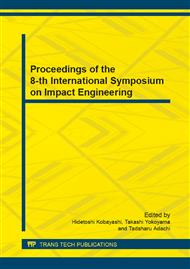p.73
p.80
p.86
p.92
p.97
p.104
p.110
p.116
p.122
Identification Methods of Parameters for Johnson-Cook Constitutive Equation – Comparison
Abstract:
The paper presents two identification methods of parameters for the Johnson-Cook constitutive equation. The Johnson-Cook equation is one of the most popular semi-empirical constitutive models to describe the equivalent of plastic stress-strain curves. The first presented method is the approximation method of plastic hardening stress-strain curves, obtained during split tension Hopkinson bar tests. The second proposed method to determine parameters of the Johnson-Cook equation is based on solutions of the inverse problem. This means that during optimization and identity calculations, physical phenomenon is simulated as, for example, an axially symmetric deformation, i. e., the Taylor impact test.
Info:
Periodical:
Pages:
97-103
Citation:
Online since:
June 2014
Keywords:
Price:
Сopyright:
© 2014 Trans Tech Publications Ltd. All Rights Reserved
Share:
Citation:


